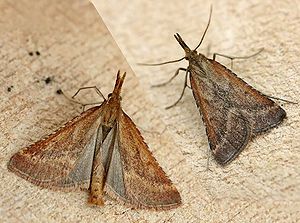Synaph punctalis
| Synaph punctalis | ||||||||||||
|---|---|---|---|---|---|---|---|---|---|---|---|---|

Synaph punctalis |
||||||||||||
| Systematics | ||||||||||||
|
||||||||||||
| Scientific name | ||||||||||||
| Synaph punctalis | ||||||||||||
| ( Fabricius , 1775) |
Synaphe punctalis is a butterfly from the family of the common borer (Pyralidae), within the superfamily Pyraloidea . The species is widespread in Europe.
features
Synaphe punctalis reaches a wingspan of 19 to 24 millimeters (22 to 27 mm). The moths are quite variable in drawing and color. The forewings have different shades of brown as the basic color, whereby the females are generally a little lighter in color than the males. The internal transverse line may be present, but is often absent. The outer transverse line is always present. Both transverse lines are usually darker than the basic color. The inner transverse line, if present, is strongly bulged outwards or slightly pointed in the middle. It is usually brightly lined on the inside. Often the root field is also a bit lighter overall. The outer transverse line kinks or bends inwards approximately in the middle of the wing. It is brightly lined on the outside; however, the light border may be missing in specimens which are already very light in the basic color, or the light border of the outer transverse line changes very gradually into the basic color. In such specimens, the midfield looks a little darker overall. A dark discal spot is often formed in the middle field. Often a darker hemline is also formed, which can be lined with light. Often the dark specimen has only a thin, light-colored hemline. Some specimens develop a few fine, white, short lines at the costal edge that run diagonally to the front edge.
The hind wings are light gray, brownish gray to blackish gray, the fringes are mostly brownish. Often an indistinct, somewhat darker center line is formed.
The caterpillar is light to dark brown or even blackish brown. The thorox is blackish; the segment incisions are darker. The head and neck are reddish brown. The pinacula are a little darker than the basic color. The adult caterpillar becomes 28 millimeters long.
Geographical distribution and habitat
The species is widespread in Europe. In the north the area extends into the southern parts of England and southern Fennoscandia . So far there are only a few certificates from Eastern Europe (Ukraine, southern Russia). It is also found in northwest Africa, Asia Minor, and North America. They live in the dry, often sandy grassland of open landscapes or in "sunny places in the pine forest ". Hannemann names "arid grassy areas and sunny mountain slopes" as living space.
Way of life
Synaphe punctalis forms one generation per year; the moths fly from June to September. The male moths also occasionally fly during the day before they settle back in the vegetation. The females, however, hide in the vegetation. Both sexes are crepuscular and nocturnal and come to light. The caterpillars can be found from August. They feed polyphag of mosses ( Hypnum spp.), Including cypress sleep Moss ( Hypnum cupressiforme ), but also from the roots of grasses and herbs, such as birdsfoot trefoil ( Lotus ) and Rockrose ( Helianthemum spp.). They live very hidden in the mosses and their own webs. It pupates in a white cocoon in the moss.
Taxonomy and systematics
The species was first scientifically described in 1775 by Johann Christian Fabricius as Phalaena punctalis . In older works the species also appears under the names Hypsopygia punctalis and Cledeobia punctalis . Hypsopygia is another, valid genus, and Cledeobia is a more recent synonym of Synaphe . Pyralis angustalis Denis & Schiffermüller, 1775 is a younger synonym of Phalaena punctalis Fabricius, 1775 and the type species from Synaphe Hübner, 1825. In the older literature, the species still appears frequently in the combination Synaphe angustalis (Denis & Schiffermüller). Thus, Phalaena punctalis Fabricius is, if not formally, in fact the typical species of the genus Synaphe . From the Mediterranean island of Corsica is the off. interrupta has been described in which the outer transverse line is interrupted. According to Slamka, however, these are only individual variations, and two other aberrations described by Corsica have been described (aurantialis Schawerda, 1926 and Kautzi Schawerda, 1932).
The species must not be confused with Pyralis punctalis Denis & Schiffermüller, 1775. This species is now part of the genus Dolicharthria Stephens, 1834.
swell
Individual evidence
- ↑ a b c d Slamka (2006: p. 26/7)
- ↑ 2255 UK Moths - Ian Kimber's website ( Memento of the original from March 4, 2016 in the Internet Archive ) Info: The archive link was automatically inserted and not yet checked. Please check the original and archive link according to the instructions and then remove this notice.
- ↑ a b Hasenfuss (1960: p. 133/4) (as Synaphe punctalis )
- ↑ Eckstein (1923: p. 61) (as Cledeobia angustalis )
- ↑ Hannemann (1964: p. 242) (as Synaphe angustalis )
- ^ Johann Christian Fabricius: Systema entomologiae: sistens insectorum classes, ordines, genera, species, adjectis synonymis, locis, descriptionibus, observationibus. Kort, Flensburg / Leipzig 1775, p. 644. (online)
literature
- Karl Eckstein: The butterflies of Germany 5th volume The small butterflies of Germany. KG Lutz Verlag, Stuttgart 1933.
- Hans-Joachim Hannemann: Small butterflies or Microlepidoptera II. The moths (sl) (Cochylidae and Carposinidae) The moths (Pyraloidea). In: Friedrich Dahl: The animal world of Germany and the adjacent parts of the sea according to their characteristics and their way of life. Part 50., Gustav Fischer Verlag, Jena 1964, DNB 458345377 .
- Ivar Hasenfuss: The Larval systematics of the bulls (Pyralidae). Akademie-Verlag, Berlin 1960, DNB 451852672 .
- Frantisek Slamka: Pyraloidea of Europe / Europa (Lepidoptera) Volume 1 Pyralinae, Galleriinae, Epipaschiinae, Cathariinae & Odontiinae. Bratislava 2006, ISBN 80-969052-3-6 .
Web links
- www.lepiforum.de Taxonomy and photos
- Moths and Butterflies of Europe and North Africa (English)
- Synaphe punctalis in Fauna Europaea. Retrieved October 27, 2011
- GlobIZ